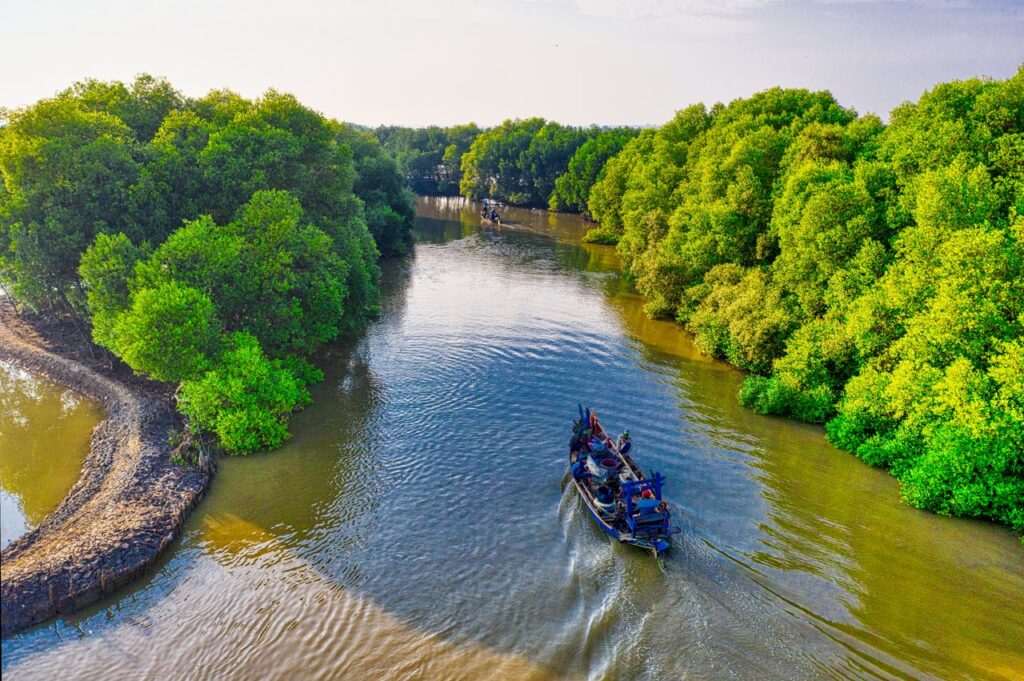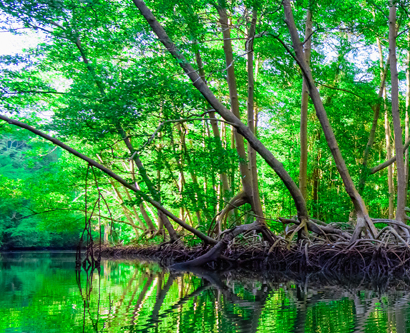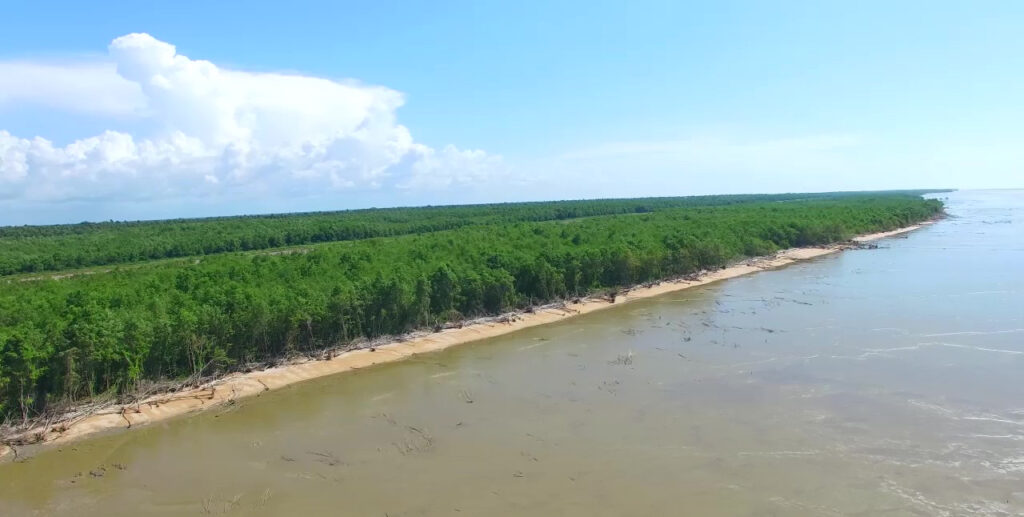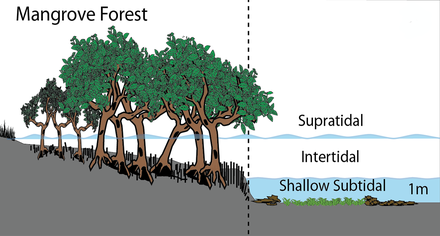Do you know about Suriname’s mangrove ecosystem? It’s a fascinating and diverse ecosystem that hides many secrets. In this article, we’ll dive into the world of Suriname’s mangroves and uncover the wonders that lie within.
Suriname, a small country located on the northeastern coast of South America, is home to a vast and intricate mangrove ecosystem. These mangrove forests not only provide shelter and food for a variety of animal species but also play a crucial role in protecting the coastline from erosion and storm surges. As you delve deeper into the article, you’ll learn about the different types of mangrove species found in Suriname and the unique adaptations they have to survive in this challenging environment. You’ll also discover the significance of mangroves in maintaining the overall health of the ecosystem and how they contribute to mitigating climate change. Stay tuned to unveil the fascinating secrets of Suriname’s mangrove ecosystem!

Overview of Suriname’s Mangrove Ecosystem
Suriname, located on the northeastern coast of South America, is home to a remarkable and diverse mangrove ecosystem. Covering approximately 3,500 square kilometers, Suriname’s mangroves play a crucial role in the coastal protection, biodiversity conservation, and economic development of the country.
Importance of Mangrove Ecosystems
Mangrove ecosystems are vital for the health of our planet. They provide numerous ecosystem services, including carbon sequestration, coastal protection, and the support of diverse marine and terrestrial wildlife. Suriname’s mangroves are no exception, boasting a wide range of unique characteristics and ecological significance.
Distribution of Mangroves in Suriname
Suriname’s mangroves can be found along the country’s coast, particularly in the areas of Nickerie, Coronie, Marowijne, and Commewijne. The distribution of mangrove forests is influenced by several factors, including tidal patterns, water salinity, and sediment deposition. These factors create a favorable environment for the growth and development of mangroves.
Unique Characteristics of Suriname’s Mangrove Ecosystem
Suriname’s mangroves exhibit distinctive features that set them apart from other mangrove ecosystems around the world. The intertidal zone is characterized by mangrove trees with specialized root structures that help them survive in the dynamic and often harsh coastal environment. The combination of unique flora and fauna species thriving in these ecosystems makes Suriname’s mangroves a truly remarkable natural wonder.
Ecological Significance of Suriname’s Mangroves
Role of Mangroves in Coastal Protection
Suriname’s mangroves act as a natural barrier against storms, tides, and erosion. The intricate root systems of mangrove trees help stabilize coastal sediments and reduce the impact of waves and currents. These protective functions not only safeguard the coast but also provide habitat for a variety of marine organisms.
Biodiversity Hotspots within Mangroves
Suriname’s mangrove forests are biodiversity hotspots, supporting a plethora of plant and animal species that are specially adapted to this unique habitat. They provide critical habitat for fish, crustaceans, mollusks, and numerous species of birds. The intricate root systems of mangrove trees also serve as nurseries for many marine organisms, contributing to the overall biodiversity of the coastal zone.
Crucial Habitat for Migratory Birds
Suriname’s mangrove ecosystems are vital stopover points for migratory birds traveling along the East Atlantic Flyway. Species such as the red knot, semipalmated sandpiper, and willet rely on the rich resources and shelter provided by the mangroves during their long-distance journeys. These birds play a crucial role in maintaining global biodiversity and ecosystem functioning.

Flora and Fauna of Suriname’s Mangrove Ecosystem
Distinctive Plant Species in Suriname’s Mangroves
Suriname’s mangroves are home to a variety of plant species that have adapted to the challenging conditions of brackish water, fluctuating tides, and high salinity. Some of the notable plant species found in Suriname’s mangroves include red mangrove (Rhizophora mangle), black mangrove (Avicennia germinans), and white mangrove (Laguncularia racemosa).
Variety of Mangrove-Adapted Animals
The diverse range of flora in Suriname’s mangrove ecosystems supports a rich array of animal life. From crabs, snails, and shrimps, to snakes, turtles, and fish, the mangroves provide a haven for numerous species. These animals have specialized adaptations to survive in the challenging conditions of the mangrove environment, such as breathing through specialized gills or navigating through maze-like root systems.
Endangered Species Found in Suriname’s Mangroves
Suriname’s mangroves are home to several endangered species that rely on these habitats for their survival. The West Indian manatee (Trichechus manatus), hawksbill turtle (Eretmochelys imbricata), and jaguarundi (Herpailurus yagouaroundi) are just a few examples of endangered species that depend on mangrove ecosystems for food, shelter, and breeding grounds. Protecting these habitats is crucial for the conservation of these vulnerable species.
Adaptations and Survival Strategies of Mangroves
Salt Tolerance Mechanisms
Mangroves have evolved various mechanisms to cope with the high salinity of their environment. Some species have specialized salt glands that excrete excess salt, while others have developed thick waxy leaves that minimize saltwater absorption. These adaptations enable mangroves to thrive in environments where most other plant species would struggle to survive.
Root Structures and Anchoring Systems
The unique root structures of mangrove trees play a vital role in their survival. Prop roots, pneumatophores, and stilt roots provide stability and prevent erosion by anchoring the trees in the muddy substrate. The intricate network of roots also facilitates nutrient uptake and provides a habitat for many organisms, forming a complex and interconnected ecosystem.
Water Regulation in Mangrove Trees
Mangroves have specialized mechanisms for regulating water intake and retention. They can filter out excess salt from seawater using their roots and store freshwater in their tissues. This ability allows them to thrive in an environment where freshwater availability fluctuates depending on tidal patterns, ensuring their survival even during droughts or periods of high salinity.

Threats to Suriname’s Mangrove Ecosystem
Deforestation and Land Conversion
One of the primary threats to Suriname’s mangrove ecosystems is deforestation and land conversion for agriculture, aquaculture, and infrastructure development. The clearing of mangroves for these purposes not only leads to the loss of habitat and biodiversity but also compromises the ability of mangroves to provide coastal protection and support local communities.
Pollution and Water Contamination
Pollution from industrial activities, improper waste management, and oil spills poses a significant threat to Suriname’s mangrove ecosystems. Chemical pollutants can accumulate in sediment, plants, and animals, affecting their growth, reproduction, and overall health. Water contamination also disrupts the delicate balance of the ecosystem, leading to the decline of important species and the degradation of their habitat.
Climate Change Impact on Mangroves
Climate change poses a severe threat to Suriname’s mangrove ecosystems. Rising sea levels, increased frequency and intensity of storms, and changes in precipitation patterns can negatively impact mangroves’ ability to survive and regenerate. It is crucial to mitigate greenhouse gas emissions and implement adaptation strategies to safeguard these valuable coastal ecosystems.
Conservation Efforts and Management Strategies
Protected Areas and Reserves in Suriname
Suriname has designated several protected areas and reserves to conserve its mangrove ecosystems. The Central Suriname Nature Reserve, Galibi Coppename Nature Reserve, and Wia Wia Nature Reserve are just a few examples of these protected areas. These areas provide legal protection, regulate human activities, and support research and monitoring efforts to ensure the long-term survival of Suriname’s mangroves.
Community-Based Mangrove Restoration Projects
Engaging local communities in mangrove restoration projects is crucial for the sustainable management of Suriname’s mangrove ecosystems. Community-led initiatives empower local residents to take an active role in conserving and restoring these natural habitats. By involving communities in planting mangrove saplings and implementing sustainable fishing practices, these projects enhance the resilience of the mangroves and promote the well-being of local communities.
Regulatory Measures and Legislation
The Surinamese government recognizes the importance of mangrove conservation and has implemented various regulatory measures and legislation to protect these ecosystems. These measures aim to prevent deforestation, regulate land-use practices, and promote sustainable development in coastal areas. Additionally, international conventions and agreements, such as the Ramsar Convention on Wetlands, further support the conservation and sustainable management of Suriname’s mangroves.

Research and Scientific Studies in Suriname’s Mangroves
Exploration of Biodiversity
Scientific research plays a vital role in uncovering the richness and complexity of Suriname’s mangrove ecosystems. From studying the diversity of plant species to documenting the abundance and distribution of animal populations, ongoing research efforts contribute to our understanding of the ecological significance and long-term viability of these habitats.
Ecosystem Services of Mangroves
Research in Suriname’s mangroves also explores the various ecosystem services provided by these habitats. By quantifying the value of coastal protection, carbon sequestration, and fisheries support, scientists can make a compelling case for the conservation and sustainable management of mangroves. This knowledge is essential for decision-makers and policymakers when formulating strategies for the protection of these valuable ecosystems.
Monitoring and Data Collection Techniques
Monitoring programs and data collection initiatives are crucial for assessing the health of Suriname’s mangrove ecosystems and tracking their response to environmental changes and human activities. Remote sensing technology, field surveys, and community-based monitoring efforts provide data on mangrove distribution, vegetation dynamics, and changes in biodiversity over time. These efforts facilitate evidence-based decision-making and help prioritize conservation actions.
Economic Value of Suriname’s Mangrove Ecosystem
Sustainable Harvesting of Mangrove Resources
Suriname’s mangroves provide a range of valuable resources that can be harvested sustainably, providing economic opportunities for local communities. The extraction of timber, fish, shellfish, and honey from mangrove ecosystems supports livelihoods and generates income. Sustainable harvesting practices, paired with appropriate regulations and community involvement, ensure the continued availability of these resources for future generations.
Ecotourism and Revenue Generation
Suriname’s mangrove ecosystems offer incredible opportunities for ecotourism, attracting visitors from around the world. Mangrove boat tours, birdwatching expeditions, and educational programs can generate income for local communities while raising awareness about the ecological importance of these habitats. By embracing sustainable tourism practices, Suriname can capitalize on the natural beauty and biodiversity of its mangroves while conserving them for future generations.
Traditional and Cultural Importance
Mangroves hold immense traditional and cultural significance for the communities living along Suriname’s coast. They serve as a source of traditional medicines, building materials, and spiritual inspiration. For indigenous and local communities, the preservation of mangroves is not only a matter of environmental conservation but also a way to protect their cultural heritage and maintain their connection to the land.

Challenges in Understanding and Preserving Suriname’s Mangroves
Complexity of Mangrove Ecosystem Dynamics
Suriname’s mangrove ecosystems are incredibly complex, with intricate interconnections between species and processes. Understanding these dynamics requires interdisciplinary research and collaboration, as well as long-term monitoring efforts. Unraveling the secrets of mangroves and developing effective conservation strategies is an ongoing challenge that requires continuous scientific inquiry.
Lack of Funding for Research and Conservation
Securing adequate funding for research and conservation initiatives is another significant challenge facing Suriname’s mangroves. Limited financial resources restrict the capacity to conduct scientific studies, implement conservation projects, and support community-based efforts. Increased investment in mangrove research and conservation is necessary to ensure the long-term survival and effective management of these valuable ecosystems.
Limited Awareness and Education
Despite their ecological and economic importance, Suriname’s mangroves often remain underappreciated and overlooked. Limited awareness and education about the value and fragility of these ecosystems hinder conservation efforts. Greater emphasis on environmental education and public awareness campaigns can help change this narrative, fostering a sense of stewardship and responsibility towards Suriname’s mangrove ecosystems.
Success Stories in Mangrove Conservation
Community-Led Restoration Projects
Several successful community-led mangrove restoration projects have demonstrated the power of local knowledge and participation. By involving communities in the planting and maintenance of mangrove seedlings, these projects have restored degraded areas, enhanced coastal protection, and created sustainable livelihoods. These success stories serve as inspirational examples of how communities can be the driving force behind mangrove conservation.
Collaborative Efforts with NGOs and Government
Collaboration between non-governmental organizations (NGOs) and government agencies has been instrumental in the conservation of Suriname’s mangroves. By combining the expertise and resources of both sectors, successful initiatives have been implemented, ranging from protected area management to policy development. These partnerships foster innovation, knowledge exchange, and effective decision-making.
Achievements in Habitat Protection
The establishment of protected areas and reserves in Suriname has resulted in significant achievements in mangrove habitat protection. These designated areas provide legal recognition and safeguards for the ecosystems, ensuring their long-term preservation. Alongside regulatory measures, active management and enforcement efforts contribute to the protection of Suriname’s mangrove ecosystems and the species that depend on them.
Future Prospects and Sustainable Development
Integration of Mangroves in Sustainable Development Goals
The United Nations’ Sustainable Development Goals (SDGs) provide a framework for global efforts to achieve a more sustainable future. Integrating the conservation and sustainable management of Suriname’s mangroves into these goals can help prioritize actions, secure funding, and promote collaboration. By recognizing the ecological, economic, and cultural value of mangroves, Suriname can contribute to multiple SDGs, including those related to climate action, biodiversity conservation, and sustainable livelihoods.
Long-Term Monitoring and Adaptation Strategies
Climate change poses significant risks to Suriname’s mangrove ecosystems. Implementing long-term monitoring programs and adaptation strategies is crucial for their survival and resilience. Regular assessment of mangrove health, tracking trends in species composition, and evaluating the effectiveness of management practices will enable informed decision-making and the development of adaptive management approaches.
Incorporation of Traditional Knowledge in Conservation
Suriname’s indigenous and local communities hold valuable traditional knowledge about the mangrove ecosystems. Including this knowledge in conservation and management strategies can enhance the resilience and success of conservation efforts. By recognizing and respecting the traditional ecological knowledge of these communities, Suriname can forge a stronger bond between cultural heritage and environmental conservation.
International Collaborations and Knowledge Sharing
Networking and Partnerships
International collaborations and partnerships play a crucial role in sharing knowledge, expertise, and resources for the conservation of Suriname’s mangroves. Networking platforms, conferences, and forums facilitate the exchange of ideas, research findings, and best practices. These collaborations strengthen global efforts in mangrove conservation and contribute to a collective understanding of the challenges and opportunities at hand.
Exchange Programs and Workshops
Exchange programs and workshops provide opportunities for capacity building and knowledge exchange between scientists, conservation practitioners, and local communities. By bringing together individuals from different backgrounds and experiences, these initiatives foster learning, innovation, and collaboration. Strengthening human capacity is essential for developing effective conservation strategies and ensuring the long-term preservation of Suriname’s mangroves.
Joint Research Initiatives
Joint research initiatives between Suriname and international partners enhance scientific understanding of mangrove ecosystems and support evidence-based decision-making. By pooling resources, sharing data, and conducting collaborative research projects, these initiatives advance our knowledge of the ecological processes, impacts of climate change, and conservation strategies for Suriname’s mangroves.
Conclusion
Suriname’s mangrove ecosystems are precious gems that hold immense ecological, economic, and cultural value. Their coastal protection functions, biodiversity hotspots, and role in supporting local communities make them an essential part of the country’s natural heritage. To unveil the secrets of Suriname’s mangrove ecosystem and ensure its long-term survival, concerted efforts in research, conservation, and sustainable management are imperative. By recognizing the importance of these unique habitats and taking action to protect them, we can preserve these natural wonders for generations to come. It is high time to unite in the call to action for the conservation and sustainable management of Suriname’s mangroves, envisioning a future where these ecosystems thrive and continue to unveil their secrets for all to behold.